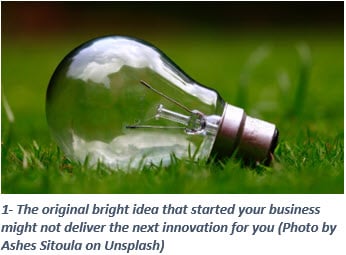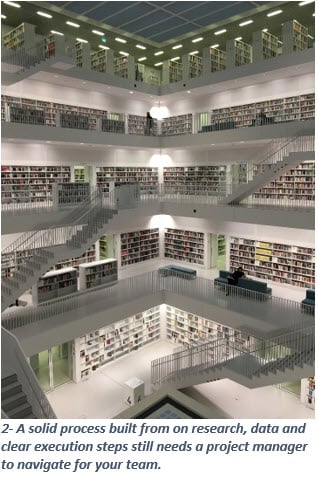
If you’re like many small manufacturers, you started your business in one of the following ways:
- You saw a gap and had an inspired idea that you turned into a successful product
- You worked for another manufacturer and saw a better opportunity to become their supplier.
- You cashed out of your first career success to fund your dream startup.
And if you are a 2nd or 3rd generation business owner, then your family likely started one of those ways too, and they did well enough to make it successful for over a full generation.
Regardless of how you started and what you started with, everyone has the same problem:
“What do we do for our next product?”
This week and next we’ll walk through a general approach to product development and some specific elements to include in building your own.
Inspiration Only Works for The First Product

The hardest part of growing is developing the next product that your customers will want after they already have your first product deployed everywhere it can go. For those manufacturers producing consumables, the problem doesn’t always exist as long as the demand for your product continues ahead of the competition, etc.
But if you are manufacturing durable goods, this sometimes means that a client with only one or two of your products won’t need another for 5-10 years…or perhaps ever. So, your sales team is forced to continually find new clients, which is hard work for the entire business – sales, marketing, and management. Your only alternative to over-investing in sales resources with diminishing returns is to develop new products.
But where to start? While your original product or product line may have been a creative idea that came to life through solid design, engineering, and testing, new products will need a better balance between your creative, inventing spirit that got you started and a more disciplined process that will provide a more systematic approach to leverage and extend that creativity into new areas.
Do You Have A Strategy?
If your product development process starts mainly with an assortment of your team sitting in a room trying to brainstorm answers to “What is the next product we should make?” then you have a very big problem in that you really aren’t working with a strategy, and almost anything else you do from that point on isn’t going to be built on a sound process.
Rather than look at your existing or potential next product for a strategy, think more broadly and ask yourself these questions:
- What problem does our product(s) solve?
- What is the outcome produced by our product(s)?
- What is the profile of our typical user/buyer/company?
- What are their other needs?
The point is that if you sell an excellent pencil, a pure product focus will lead you to think you need to make an even better pencil or a slightly different one. But if you answer the above questions like this:
- Frequent sharpening required, fuzzy and broken lines
- Improved clarity of lines for sketches and designs, less erasing
- Designer/draftsperson
- Precision straight-edge rulers, high-performing drafting tables, lighting
See the difference? Yes, you may find a path to create a series of amazing pencils that are all slightly different enough for your customers to want one of each, but the bigger picture means you need to develop a strategy around your customer’s greater set of needs and NOT just what you think you’d like to make.
A Process Both Harnesses and Frees Your Creativity
For many inventive entrepreneurs, the word “process” is a synonym for “shackles.” It is, however, quite the opposite. By building a reliable process to execute on your strategy, the total universe of potential ideas you need to work with is reduced to a smaller space that lets you avoid a lot of wasted energy and thinking in spaces where you don’t belong (i.e., the designer does not need your waste can or break room coffee machine ideas).
With a sound strategy that lets you think bigger and a process that defines boundaries for you, the quality of the ideas will improve dramatically. While the concrete steps swim lanes and handoffs in your process will be customized to fit your business, there are three elements you should be including:
You want to avoid getting into the habit of running with the ideas coming from the loudest people in the room. Use your data (which should be getting uncovered while building your strategy).
A budget will also limit your commitment to fewer, but better-vetted projects. Ensure this happens through a continuous dialog with customers (mostly “listening”!), customer data, market research and industry trends.
If you’re a smaller manufacturer without these internal skills, there are plenty of skilled people out there you can bring to get you started and be a driving force that an outsider can sometimes deliver better than your internal team who may have multiple hats to wear along with significant unstructured work that may pull them away from the product development.
Start Planning Next Year’s Budget and Process Today
If you want to see a new product make an impact on your bottom line in 2020 (sorry, you’re already too late for 2019!), then it is time to start the planning NOW. Spend the next four months collecting data, engaging customers, identifying a leader (or outside resource) and pulling your team together to start building consensus for your new process.
In the next article, we will dive into some of the specifics of a sample process and what is included in the steps.